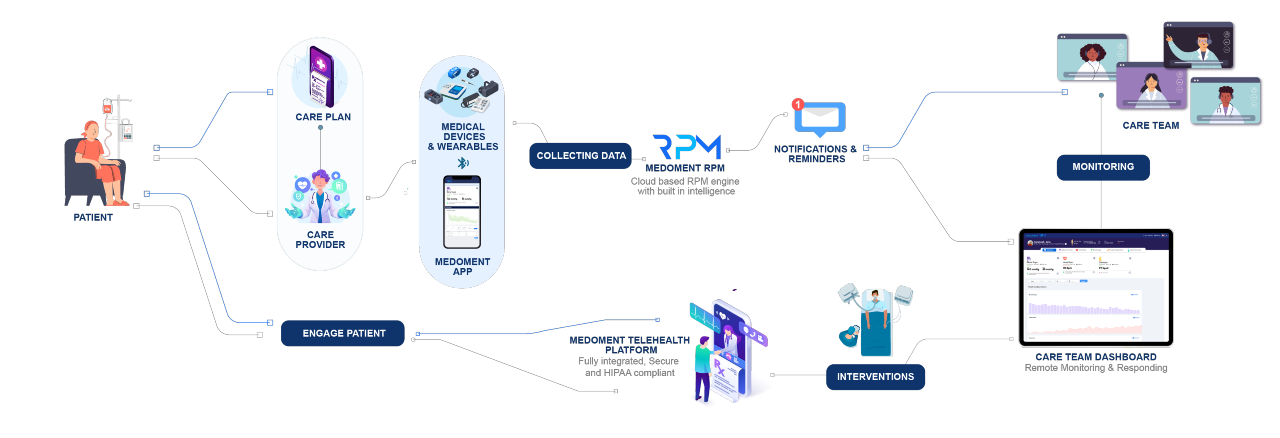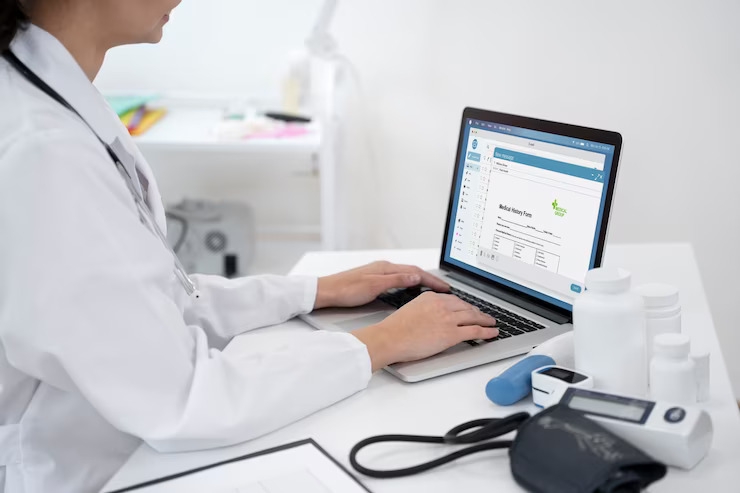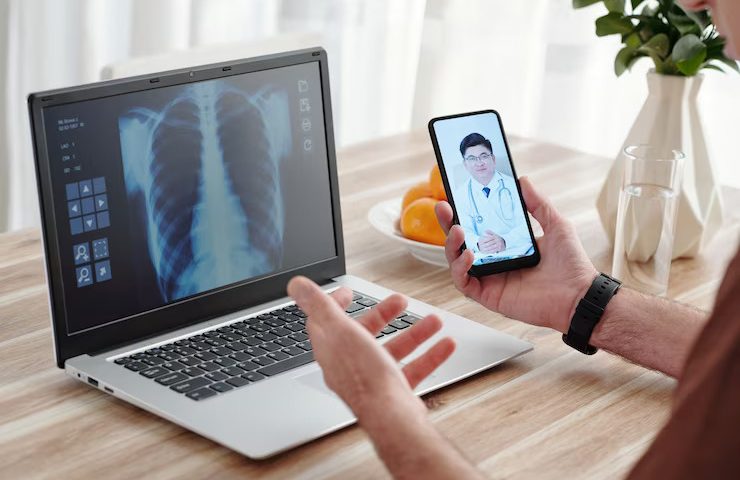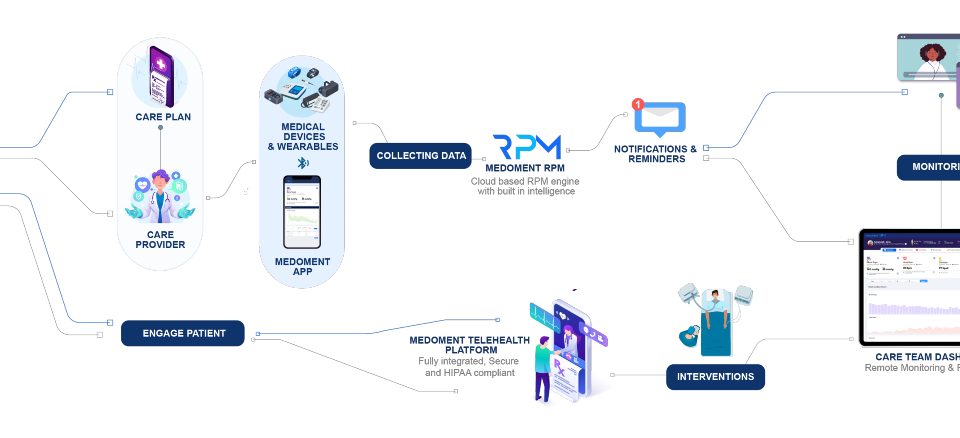
Can telemedicine help reduce the impact of cardiovascular diseases?
March 15, 2023
7 Benefits of Medoment RPM for Your Practice
May 23, 2023Remote patient monitoring (RPM) is the use of technology to monitor patient health outside of a traditional clinical setting. Health data is transmitted to healthcare providers via digital, wireless or Bluetooth methods. Many patients can potentially benefit from RPM, especially those living with chronic diseases.

What are the benefits of RPM for Chronic Disease Management?
Remote patient monitoring enables:
● Better preventive management, by detecting any deterioration in a condition before symptoms appear.
● More accurate monitoring of trends in disease and symptom progression over time.
● Improved chronic care management, through timely adjustments to treatment plans.
● Reduced risk of exposure to communicable diseases during clinic visits.
● Improved communication and patient engagement with healthcare providers.
● Increased likelihood of healthier lifestyle choices and adherence to treatment, as patients know their care provider is regularly checking their health data.
● Reduced burden on limited hospital resources.
● Greater convenience, time and cost savings for patients.
● Improved self-management and patient satisfaction.
● Reduced number and length of hospital stays and readmissions, as patients can be safely managed from home.
Chronic Disease Management with Remote Patient Monitoring
RPM is useful for any condition that requires regular monitoring and for which home monitoring devices are available. Patient-generated health data (PGHD) is created, recorded, or gathered by or from patients, family members or other caregivers. Transmitted health data is securely stored in electronic medical record (EMR) systems. Advanced technologies now enable data from wearable connected devices to be automatically transmitted to healthcare providers in real time. Abnormal readings or changes in a patient’s condition may be flagged to alert clinicians, prompting an urgent follow-up and modification of care plan where required.
Some examples of current uses of RPM include:

Hypertension and Cardiovascular Disease
Connected digital blood pressure monitors remotely transmit blood pressure and heart rate data. Wearable devices are used for remote ECG monitoring and can also track oxygen saturation and heart rate throughout the day. A 2022 study published in the Journal of General Internal Medicine, found that home-based blood pressure (BP) measurements were more reliable and accurate than those taken in clinics or kiosks.
Chronic heart failure
RPM can be used to monitor vital data, such as heart rate, rhythm and blood pressure. Connected smart weighing scales can be useful for individuals with congestive heart failure, where a sudden weight gain may alert to fluid retention. A review of research studies involving chronic heart failure (CHF) patients found that remote monitoring with structured telephone support was effective in reducing the risk of all-cause mortality and CHF-related hospitalisations, as well as improving quality of life and reducing costs.
Diabetes
Continuous glucose monitoring systems provide better monitoring than fingerstick home testing. They continuously monitor blood glucose throughout the day via a small sensor inserted into the skin of the abdomen. Some systems send blood sugar level alerts or reminders to take medication. Smart insulin delivery systems like pumps and pens can also calculate and track insulin dosage data. Studies have shown the benefits of RPM for both type 1 and type 2 diabetics, in improving blood glucose control over the long term.

Chronic kidney disease
Remote monitoring is showing promising results for home dialysis patients. One study found that the use of RPM for automated peritoneal dialysis (APD) patients was associated with significantly lower hospitalisation rates and fewer hospitalisation days.
Chronic respiratory diseases
Remote electronic respiratory monitors can be helpful in the management of Chronic Obstructive Pulmonary Disease (COPD), asthma and other respiratory diseases. RPM has been successfully used for the early identification and treatment of COPD exacerbation.

The future of RPM for Chronic Disease Management
Remote Patient Monitoring is becoming a new standard for chronic disease management. The global RPM market is growing, predicted to reach $117.1 billion by 2025, compared to $23.2 billion in 2020. An increasing number of remote monitoring devices are being developed for a wide variety of conditions. Patients are becoming more familiar and comfortable with wearable devices.
Continuing advances in data analysis, AI and machine learning have the capability to automate some of most of the repetitive monitoring tasks, giving healthcare professionals more time freeing up more time to interact with patients and manage their care.
Are you looking for the ideal RPM and telemedicine software?
Realise the full potential of integrated RPM and telemedicine with Medoment’s innovative and comprehensive patient engagement platform.
MEDOMENT is a complete healthcare engagement solution that optimises user experience and improves outcomes by integrating remote patient monitoring software, teleconsultations and a patient engagement portal within a single platform. MEDOMENT complies with the highest international standards for data security and protection.
RECENT POSTS
- 7 Benefits of Medoment RPM for Your Practice
- Remote Patient Monitoring for Chronic Disease Management
- Can telemedicine help reduce the impact of cardiovascular diseases?
- Can telemedicine be used during pregnancy?
- Can Telemedicine Improve Diabetes Management?
- How to conduct a physical exam via telemedicine
- How can MEDOMENT Optimise Patient Engagement?
- Can patient engagement portals improve healthcare?
- How to choose the right telemedicine software partner
- How to invest in telemedicine software

